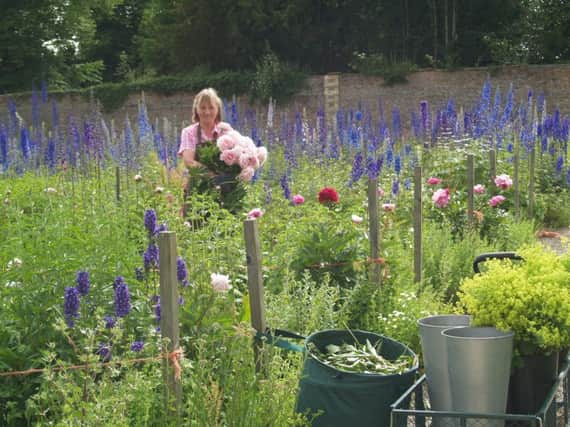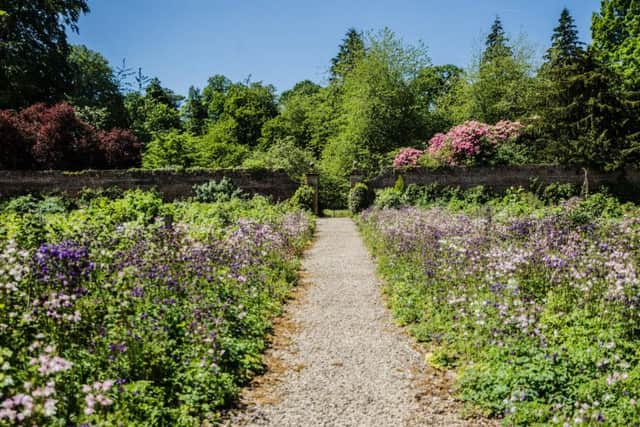The miraculous transformation of Swinton Park gardens


When Susan Cunliffe-Lister’s family returned to their ancestral home back in 2000 the now beautiful gardens and acres of parkland looked very different. The gardens were overgrown, trees and shrubs had all but disappeared from the parkland and the walled garden had been used to grow Christmas trees.
Although spring has only just sprung, looking at the estate now it is hard to believe the transformation.
“It was quite an undertaking to begin with,” Susan says, somewhat understatedly.


Susan’s son Mark, the Baron of Masham, and his wife Felicity converted the family home into a hotel in 2001. They had bought the Swinton Estate back in 2000 – 25 years after it was sold to an educational trust. As a keen gardener, Susan took on responsibility for restoring the grounds.
Today, she takes care of the gardens around Home Lake and the walled garden – used to help stock Swinton Estate’s restaurants. “It was pretty overgrown when we started so we cut everything back and started to develop the wild flowers,” says Susan. “The first time I counted we had about 10 wild orchids and last time I counted we had about 600.”
Today’s lake gardens feature wild trees including azaleas and rhododendrons as well as lots of daffodils.
“They are great survivors, they don’t get eaten by the rabbits and come up before most of the other flowers,” says Susan. “They were quite fashionable when the gardens were being planted back in the 19th century so we have lots of older varieties.”


So does Susan have a favourite flower or part of the garden?
“At different times of year there are different things that are lovely,” she says. “In the walled garden when all the roses come out or all the delphiniums bloom and have bees in them, in the woods when the snowdrops appear.”
But with a kitchen to stock, it was important to Susan to quickly get the walled garden back in use as quickly as possible.
“To get the walled garden up and running again, we developed a new way of growing all the vegetables and fruit which is pretty low maintenance,” she said.


Susan and the other gardeners put down a membrane covered in gravel, allowing herbs and other plants to seed themselves. They also introduced raised beds to grow some of the smaller vegetables. When we speak, the spring broccoli has just started to sprout and Susan is expecting the first large crop of the year to be a ‘huge bed of asparagus’, although the late snow has had an impact.
“I do enjoy growing the vegetables, I must say it is really satisfying seeing the chefs come and pick them and choose what they want for the kitchens,” she tells me. “It is a bit more fun than just ordering it, like a kind of foraging.”
Susan says the annual crop of wild strawberries is particularly popular, although it is ‘quite a big job’ just to keep up with the chefs.
So what tips would Susan offer to someone looking to start growing their own fruit and vegetables at home?


“I have found some brilliant raised beds which you can make really easily called GrowRings,” she says. The GrowRings clip together to make a circle which can be filled with compost. Susan, who has ‘getting on for 60’ in her garden says they are ideal for produce like baby carrots and turnips. “A circle is a brilliant thing to have a raised bed in because it is easy to cover with a net to protect it from birds and getting to it is really easy.”
In terms of what to grow, she recommends red Russian kale and courgettes for beginners. “If people want to grow vegetables at home I would always go for courgettes because you get lots and lots of courgettes from one plant.”
So what has Susan got planned for the future of Swinton Park’s gardens?
“Keeping up with the chefs and all the new things they discover and want to grow,” she laughs. “It would be lovely if we could control the weather a bit better as well. Last year we had 1,000 figs on the fig trees and the year before we had nine.
“But it is just fun finding new things to grow.”
Visitors are welcome to walk in the Swinton Park grounds throughout the year – it can take up to two-and-a-half hours to complete all the routes. The parkland supports a herd of around 100 fallow deer, while the four-acre walled garden is now used to grow more than 60 varieties of fruit and vegetables. For more information, visit www.swintonestate.com.